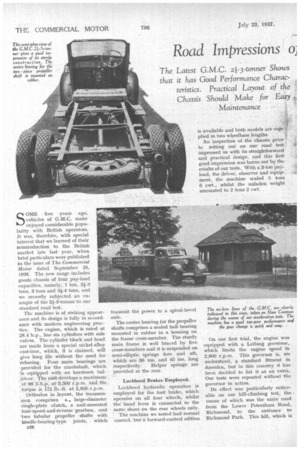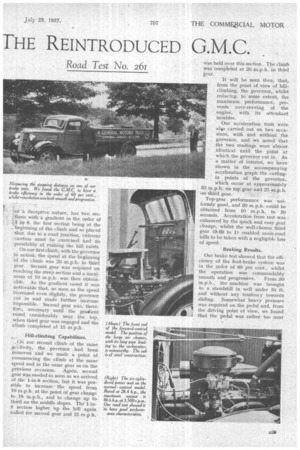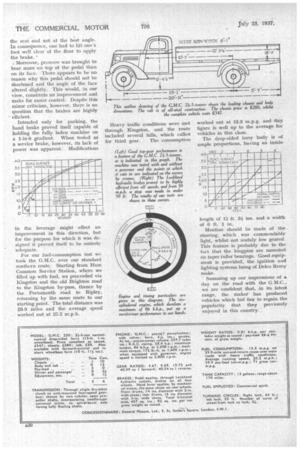Road Impressions o,
Page 42

Page 43

Page 44

If you've noticed an error in this article please click here to report it so we can fix it.
FFIE REINTRODUCED G.M.C.
The Latest G.M.C. 2I-3-tonner Shows that it has Good Performance Charac, teristics. Practical Layout of the Chassis Should Make for Easy Maintenance SOME five years ago, vehicles of G.M.C. make enjoyed considerable popularity with British operators.
was, therefore, with special interest that we learned of their reintroduction to the British market late last year, when brief. particulars were published in the issue of The Commercial Motor dated September 25, 1936. The new range includes goods chassis of four pay-load capacities, namely, 1 ton, 24-3 tons, 3 tons and 34-4 tons, and we recently subjected an example of the 24-3-tonner to our standard road test.
The machine is of striking appearance and its design is fully in accordance with modern engineering practice. The engine, which is rated at 28.4 h.p., has six cylinders with side valves. The cylinder block and head are made from a special nickel-alloy cast-iron, which, it is claimed, will give long life without the need for reboring. Four main bearings are provided for the crankshaft, which is equipped with an harmonic bal;ancer. The unit develops a maximum Of 86 b.h.p. at 3,500 r.p.m. and the _torque is 112 lb.-ft. at 2,800 r.p.m.
• Orthodox in layout, the transmis.sion comprises a large-diameter • single-plate clutch, a unit-mounted four-speed-and-feverse gearbox, and two tubular propeller shafts with 'needle-bearing-type joints, whioh.
B28 transmit the power to a spiral-bevel axle.
The centre bearing for the propeller shafts comprises a sealed ball bearing mounted in rubber in a housing on the frame cross-member. The sturdy main frame is well braced by five cross-members and it is suspended on semi-elliptic springs fore and aft, which are 36 ins. and 45 ins. long respectively. Helper springs are provided at the rear.
Lockheed Brakes Employed.
Lockheed hydraulic operation is employed for the foot brake, which operates on all four wheels, whilst the hand lever is connected to the same shoes on the rear wheels only.
The machine we tested had normal control, beta forward-control edition On our first trial, the engine was equipped with a Leibing governor, which limits the engine speed to 2,800 r.p.m. This governor is, We understand, a standard fitment in America, but in this country it has been decided to list it as an extra. Our tests were repeated without the governor in action.
Its effect was particularly noticeable on our hill-climbing test, the venue of which was the main road from the Lower Petersham Road, Richmond, to the entrance to Richmond Park. This hill, which is
-of a deceptive nature, has two sec:lions with a gradient in the order of iii 8 the first sectio,n being at the . beginning of the climb and so placed that, due to a road junction, extreme caution must be exercised and no possibility of rushing the hill exists. On our first climb, with the governor in action, • the speed at the beginning • of the climb was 20 m.p.h. in third gear. Second gear was required on reaching the steep section and a maximum of 10 m.p.h. was then obtainable. As the gradient eased it was noticeable that, so soon as the speed increased even slightly, the governor cut in and made further increase impossible. Second gear was, therefore, necessary until the gradient eased considerably near the top, when third gear was engaged and the climb completed at 15 m.p.h.
Hill-climbing Capabilities.
On our second climb of the same .acclivity, the governor had 'been removed and we made a point of commencing the climb at the same speed and in the same gear as on the previous occasion, Again, second gear was needed as soon as we arrived at the 1-in-8 section, but it was possible to increase the speed from 10 m.p.h., at the point of gear change to 18 m.p.h, and to change up to third on the middle slopes. The 1-in8 section higher up the hill again called for second gear and 15 m.p.h. was held over this section. The climb was completed at 20 m.p.h. in third
gear. .
It will be seen then, that, from the point of view of hillclimbing, the governor, whilst reducing, to some extent, the maximum performance, prevents over-revving of the engine, with its attendant troubles.
Our acceleration tests were
al l.° carried, out on two occasions, with and without the governor, and we noted. that the two readings were almost identical until the point at which the governor cut in. As a matter of interest, we have shown. in the accompanying acceleration graph the cuttingin points of the governor, which occur at approximately 35 m.p.h. on top gear and 25 m.p.h.
on third gear.
Top-gear performance was uni formly good, and 30 m.p.h. could be obtained from 10 m.p.h. in 30 seconds. Acceleration from rest was enhanced by the quick and easy gear change, whilst the well-chosen third gear (9.69 to 1) enabled main-road hills to he taken with a negligible loss of speed.
Braking Results.
Our brake test showed that the efficiency of the foot-brake system was in the order of 60 per cent., whilst the operation was commendably smooth and progressive. From 30 m.p.h., the machine was brought to a standstill in well under 50 ft. and without any tendency towards sliding. Somewhat heavy pressure was required on the pedal and, from the driving point of view, we found that the pedal was rather too near
the seat and not at the best angle. In consequence, one had to lift one's foot well clear of the floor to apply the brake. • Moreover, pressure wasbrought to bear more on top of the pedal than on its face. There appears to be no reason why this pedal should not be shortened and the angle of the face altered slightly. This would, in our view, constitute an improvement and make for easier control. Despite this minor criticism, however, there is no question that the brakes are highly ' efficient.
Intended only for parking, the hand brake proved itself capable of holding the fully laden machine on a 1-inz8 gradient. When tested as a service brake, however, its lack of power was apparent. Modifications in the leverage might effect an improvement in this direction, but for the purpose for which it was designed it proved itself to be entirely adequate.
For our fuel-consumption test we took the G.M.C. over our standard southern route. Starting from Ham Common Service Station, where we filled up with fuel, we proceeded via Kingston and the old Brighton road to the Kingston by-pass, thence by the Portsmouth road to Ripley, returning by the same route to our starling point. The total distance was 29.9 miles and the average speed worked out at 25.2 m.p.h. Heavy traffic conditions were met through Kingston, and the route included several hills, which called for third gear. The consumption worked out at 13.3 mpg. and this figure is well up to the average for vehicles in this class.
The drop-sided lorry body is of ample proportions, having an inside length of 12 ft. 3i ins, and a width of 6 ft. 1 in.
Mention should be made of the steering, which was commendably light, whilst not unduly low geared. This feature is probably due to the fact that the kingpins are mounted on taper roller bearings. Good equip. rnent is provided, the ignition and lighting systems being of Delco Remy make.
Summing up our impressions of a day on the road with the G.M.C., we are confident that, in its latest range, the maker has produced vehicles which bid fair to regain the popularity that they previously enjoyed in this country.




























































































